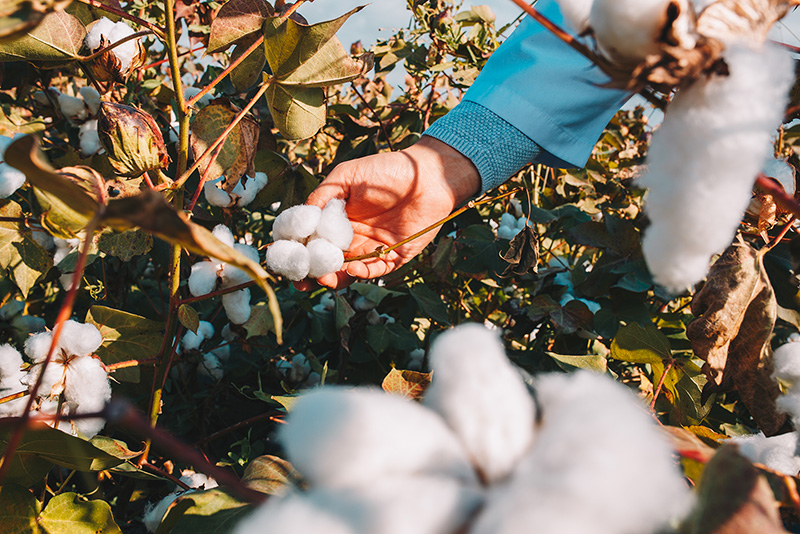Blog
Why organic cotton?

What are the best clothes for my baby?
As a parent, you want the best for your baby and deciding on what are best clothes it is not easy at all. You probably consider factors such as safety, comfort and environmental impact, as well as price and durability.
Most of us think of cotton as the best option, since it is a natural, vegan and biodegradable, as well as washable, absorbent, breathable and strong. Therefore, it naturally becomes the perfect sustainable fabric. But is this true?
Unfortunately, growing and producing conventional cotton has a very high environmental footprint. Starting with the degradation of soil due to cotton farming expansion to new arable areas destroying natural habitats, transport of the giant bales of cotton from fields to textile mills requiring a lot of energy, different fossil fuels used to power the cotton mills, and finalizing with production practices that involve the use of large quantities of chemicals and water. This doesn’t make the conventional cotton the safest option for your baby.
Toxic clothes
Conventional cotton uses around 6% of the world’s pesticides and 16% of all insecticides to keep the crops safe from insectile interruption. In fact, according to the World Health Organization, the most common insecticides used in cotton production are three of the most hazardous chemicals. This is not only result in health risks for cotton farmers, but these toxic substances also pollute whole ecosystems and thousands of litres of drinkable water. Some of the harsher ones end up in your baby clothes, which can cause allergic reactions and irritations.
Water usage and pollution
Most of the water used to grow cotton is from irrigation, taking this away from natural resources and people. It takes from 7,000 to 29,000 litres of water to produce one kilogram of cotton, and 2,700 litres of water to produce a single cotton t-shirt. As a result, one of the largest lakes in the world, Aral Sea in central Asia, has shrunk by a half of its original size due to unsustainable cotton cultivation which started in 1950s.
On top of that, the dyes used later in the production process also use chemicals which then end up in the waterways. Many rivers in Asia and Africa are dyed in blue or read due to these harmful production processes.
Cotton clothing biodegradability
Although cotton is a natural fibre and as such should be biodegradable, this is not the reality for most today. Chemicals used to grow cotton in crops and to produce cotton clothing, or the use of other synthetic fibres mixed with cotton to produce clothing result in the loss of this sustainable characteristic.
Is there an alternative to produce a more sustainable product lowering environmental impact?
Organic cotton could be the answer. It uses a much more sustainable process being less environmentally destructive. Organic cotton production is eco-friendly, focusing on maintaining the soil fertility, preventing soil erosion and growing cotton without involving toxic and synthetic pesticides and fertilisers or any harmful chemicals. This results in the growth of different varieties of plants and animals, key for a sustainable future. A healthy soil produces more crops, but also absorbs more CO2, key to mitigate climate change.
What are the benefits of organic cotton on my baby?
Babies and infants have a much more sensitive and permeable skin than adults. Therefore, they absorb more from their environment. Organic cotton is a non-hypoallergenic material. It is soft, comfortable and breathable, and it maintains the body temperature of your baby.
It is very important to use materials that don’t include harmful chemicals which can cause allergies and irritations on the skin. Sustainable production of the fabric is however only the first step. The next step is the dying process which should also be natural and sustainable avoiding harsh chemicals.
Overall, organic cotton is a better option for our environment and our babies, but also a more responsible way of consumption. It contributes and supports ethical production, helps farmers by paying a fair wage as well as them not having to use harmful chemicals.
How do I recognize clothing it is made of organic cotton and doesn’t involve any harmful chemicals?
It is very important that the clothing is not being mixed with other synthetic fibres, so 100% organic cotton is the best option. To ensure that the organic cotton farms are sustainable, and no pesticides, fertilisers and chemicals are being used, check that the fabric is GOTS certified (Global Organic Textiles Standard). This would also apply for the dye used, being it natural or GOTS certified dyeing.
Oodles & Caboodles baby clothes are made of 100% GOTS certified organic cotton and are also dyed only with GOTS certified dyes. We aim for even a better and more sustainable future, in which fewer natural resources are being used to produce our clothes.
We believe we can soon offer our products being made of post-consumer recycled organic cotton, closing the loop, ensuring our clothes don’t end up in the landfill and turning waste into “nutrients” for a new product without using new natural resources.
